Six Flags Great America – Gurnee, Illinois
Whizzer
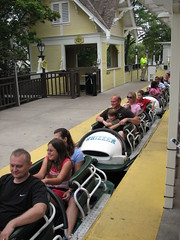 Is there no pride left in being a family coaster? Have we really gotten to the point that if a park wants to add a family ride it has to be brief, compact, brightly colored and spinning? What happened to the days when a coaster could be a genuine work of art while still being accessible to entry-level riders? With Big Bad Wolf now gone the Whizzer could very well be the best example of a classical family coaster that’s just as appreciated whether it’s your first coaster or your four-hundredth. Whizzer could even be the best coaster in the park. I’m not sure if I would personally make that claim (see below) but it’s not hard to see how someone could. From the layout to the rolling stock to the natural setting in the center of the park (did that land really used to be a flat cleared field?) the Whizzer is full of unique character.
Is there no pride left in being a family coaster? Have we really gotten to the point that if a park wants to add a family ride it has to be brief, compact, brightly colored and spinning? What happened to the days when a coaster could be a genuine work of art while still being accessible to entry-level riders? With Big Bad Wolf now gone the Whizzer could very well be the best example of a classical family coaster that’s just as appreciated whether it’s your first coaster or your four-hundredth. Whizzer could even be the best coaster in the park. I’m not sure if I would personally make that claim (see below) but it’s not hard to see how someone could. From the layout to the rolling stock to the natural setting in the center of the park (did that land really used to be a flat cleared field?) the Whizzer is full of unique character.
It starts with the trains, which are designed placing riders inline, allowing two people to share in the excitement of the ride together if they wish, and for single riders there is plenty of legroom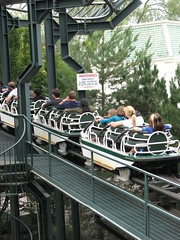 and the restraints (basically a seatbelt and that’s it) are as non-restrictive as they come without being altogether missing. The low-slung sides also allow for one plenty of visual freedom, as well as increasing the sense of exposure to the surroundings as you feel as though you could easily reach out and grab leaves off the trees if you really wanted to. The spiral lift is an oddity in itself and is a unique way to start the ride off. The motors that power it uphill are actually located inside the trains, although I’m not sure if they’re powered from an electrical strip running along the lift or are completely self-contained (I’m guessing the former). It takes a while to get to the top as well, not because the motor is slow but because it takes so much track to wrap around three and a half times that it can take well over a minute before we get to the top.
and the restraints (basically a seatbelt and that’s it) are as non-restrictive as they come without being altogether missing. The low-slung sides also allow for one plenty of visual freedom, as well as increasing the sense of exposure to the surroundings as you feel as though you could easily reach out and grab leaves off the trees if you really wanted to. The spiral lift is an oddity in itself and is a unique way to start the ride off. The motors that power it uphill are actually located inside the trains, although I’m not sure if they’re powered from an electrical strip running along the lift or are completely self-contained (I’m guessing the former). It takes a while to get to the top as well, not because the motor is slow but because it takes so much track to wrap around three and a half times that it can take well over a minute before we get to the top.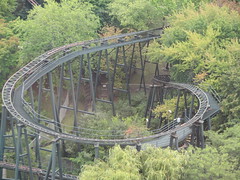
The first half of the Whizzer is exceptional, with no steep drops to speak of but some long runways that quickly build momentum and lets the train fly effortlessly through ground-level turns along the forest floor. These are well-balanced with slower moments circling around the canopies, allowing time to breath. The first drop in particular can even be a bit intimidating, recalling in some ways the Beast’s incredible finale, with a long, shallow descent accumulating speed before that potential energy explodes into kinetic as it plows around the sharp turn through the trees at the bottom, making me wish for a moment I had more holding me into the trains than just this flimsy little seatbelt.
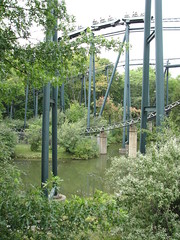 After this first half and it makes its way around the lift, the coaster doesn’t thrill me as much. It wanders through some s-turns halfway between ground and sky, finishing the layout with a downward helix. I think Schwarzkopf could have done something better than a helix, that’s a bit too easy and simple a solution, and one that feels a tad overused. Overall I think the finale doesn’t quite fulfill the promise of the first half, and the ride is slightly uneven in that regard, since I imagine young coaster riders might be too frightened by the more intense opening act, and then, once they’ve gotten used to the ride experience, there’s nothing new to challenge them in the second half.
After this first half and it makes its way around the lift, the coaster doesn’t thrill me as much. It wanders through some s-turns halfway between ground and sky, finishing the layout with a downward helix. I think Schwarzkopf could have done something better than a helix, that’s a bit too easy and simple a solution, and one that feels a tad overused. Overall I think the finale doesn’t quite fulfill the promise of the first half, and the ride is slightly uneven in that regard, since I imagine young coaster riders might be too frightened by the more intense opening act, and then, once they’ve gotten used to the ride experience, there’s nothing new to challenge them in the second half.
Still, the setting is fantastic, and the places along the course where there’s not as many trees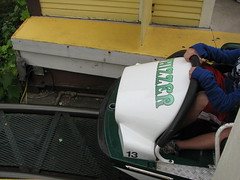 as I’d like only highlight how dense the foliage is around some of the other parts. Needless to say, this was the one coaster I wanted to end the day with, and the nighttime atmosphere does improve the ride a great deal, even if there are a few more lights along the course than I would have liked. Overall this is still a must-ride for anyone visiting the park, whether you’re a thrill seeker normally only interested in the headlining B&M attractions or new to roller coasters altogether. The very thought that this could have been removed for Superman back in 2002 is quite upsetting, but clearly I was not alone in those sentiments as the ride remains running to this day.
as I’d like only highlight how dense the foliage is around some of the other parts. Needless to say, this was the one coaster I wanted to end the day with, and the nighttime atmosphere does improve the ride a great deal, even if there are a few more lights along the course than I would have liked. Overall this is still a must-ride for anyone visiting the park, whether you’re a thrill seeker normally only interested in the headlining B&M attractions or new to roller coasters altogether. The very thought that this could have been removed for Superman back in 2002 is quite upsetting, but clearly I was not alone in those sentiments as the ride remains running to this day.
Demon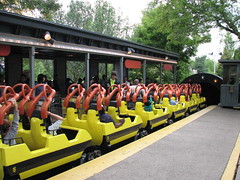
If all of Six Flags Great America’s coasters went to high school, Demon would be the shrimpy nerdy one that’s convinced he’s really the most totally awesome thing since the invention of the printing press. It’s got the all-black paint scheme with goofy rock-face structures, two special effects tunnels that try to dazzle and impress even though they used these big, carnival style incandescent light bulb strips, and of course the old “Demon Song” was playing all over the station. Step into the Demon queue and you’ll be directly transported back into 1979.
The coaster itself is a pretty decent riding experience. I got a couple late evening/early night rides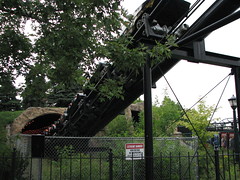 and that really improved the ride experience in the tunnels and out on the farther unlit portions of the course. You do have to be of a certain height to enjoy these Arrow looping coasters, as too short can mean the horsecollar restraints connect with your earlobes, and too tall means they fit uncomfortably tight on top of your shoulders. If you’re in the intended height range then the first drop and two loops can be a fun, intense and dizzying affair. I’d be curious to know how it was back when it was the Turn of the Century and had two camelback hills where the loops are today; they looked like more extreme versions of Cedar Point’s Corkscrew’s single air hill and that one is quite intense by itself.
and that really improved the ride experience in the tunnels and out on the farther unlit portions of the course. You do have to be of a certain height to enjoy these Arrow looping coasters, as too short can mean the horsecollar restraints connect with your earlobes, and too tall means they fit uncomfortably tight on top of your shoulders. If you’re in the intended height range then the first drop and two loops can be a fun, intense and dizzying affair. I’d be curious to know how it was back when it was the Turn of the Century and had two camelback hills where the loops are today; they looked like more extreme versions of Cedar Point’s Corkscrew’s single air hill and that one is quite intense by itself.
Things like the long straightaway in the special effects tunnel after the loops do help make the ride experience a fun one, cheesy as they are. The second half after the tunnel doesn’t have quite as much going for it as the first, the turnaround taking a while to get through and then the corkscrews over the railroad tracks and final helix are both a bit slower paced and a bit rougher, but it helps round out the ride experience to feel more complete than some of the other early small-scale Arrow multiloopers that charge through the course in less than 45 seconds. Honestly I don’t miss the Shockwave at all since the park still has the Demon, whose mixture of low-key, small scale thrills with a larger-than-life persona and a full-on 80’s cheese fest, make it one of the most purely fun coasters in Six Flags Great America.
in the special effects tunnel after the loops do help make the ride experience a fun one, cheesy as they are. The second half after the tunnel doesn’t have quite as much going for it as the first, the turnaround taking a while to get through and then the corkscrews over the railroad tracks and final helix are both a bit slower paced and a bit rougher, but it helps round out the ride experience to feel more complete than some of the other early small-scale Arrow multiloopers that charge through the course in less than 45 seconds. Honestly I don’t miss the Shockwave at all since the park still has the Demon, whose mixture of low-key, small scale thrills with a larger-than-life persona and a full-on 80’s cheese fest, make it one of the most purely fun coasters in Six Flags Great America.
Viper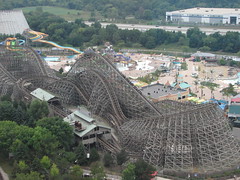
I was looking forward to this one. I really liked it back in 2003, but wasn’t so keen on it in 2005 when it seemed much rougher. However most of the reviews I read online seemed to corroborate better with my 2003 opinion, saying it tracks incredibly well and even that it could be Six Flag’s best wooden coaster after El Toro. After getting three rides on it this year (back row, front row and 1-3) I have to say that while the first part of those claims is very true (that it’s very smooth and well-maintained) I can’t agree with the second part. As another Cyclone-clone, this one seemed relatively conservative and didn’t do much for me.
It’s still a very fun ride,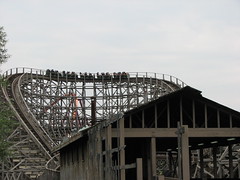 and easily accessible to people unsure about wooden coasters. The station and setting is great, the structure looks magnificent from off-ride, the two thirty-passenger trains keep the line moving, and best of all it is impeccably maintained. It feels like luxury shock absorbers have been retrofitted to the trains, so smooth do we sail over airtime hills and turns with no loss of pace due to potholing or shuffling that normally plagues wooden coasters from this era. I couldn’t be sure but it appeared as though there were more layers of wood that make up the track than on normal wooden coasters.
and easily accessible to people unsure about wooden coasters. The station and setting is great, the structure looks magnificent from off-ride, the two thirty-passenger trains keep the line moving, and best of all it is impeccably maintained. It feels like luxury shock absorbers have been retrofitted to the trains, so smooth do we sail over airtime hills and turns with no loss of pace due to potholing or shuffling that normally plagues wooden coasters from this era. I couldn’t be sure but it appeared as though there were more layers of wood that make up the track than on normal wooden coasters.
So why do I merely give it a passing grade? I think it was just that the coaster lacked much bite. The bookending fan turns in particular were a bit of a snooze,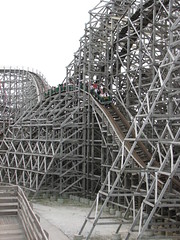 the first one with very gentle lead-ins/outs taking far too long to complete, and the others feeling very controlled and forceless as well. There was none of the sharp snaps over the crests of the dives that I loved on the Georgia Cyclone. The centerpiece airtime hills and drops were a bit better, but again in all seats they lacked any sort of aggressiveness, instead opting for smooth, sustained floater air. That’s alright in most cases, but not for a ride based on the Cyclone where I expect more out-of-control intensity. Regardless, this isn’t the ideal layout for that type of airtime since only one or two hills are achieved before the pace has to halt for another fan turn that accomplishes little besides turning the train around again. Probably the most effective moment was the double dip off the second turn and the sharp, straight camelback hill buried in the lift super structure that followed. Intense, yes. Aggressive, not quite; the transitions were still feather-light and lacked the snap I normally associate with these rides. It’s not enough to just be held out of my seat, I want to be jolted out of it. Maybe it was just a case of having the wrong expectations, but I personally would take the other, edgier Cyclone counterparts over this one any day of the week.
the first one with very gentle lead-ins/outs taking far too long to complete, and the others feeling very controlled and forceless as well. There was none of the sharp snaps over the crests of the dives that I loved on the Georgia Cyclone. The centerpiece airtime hills and drops were a bit better, but again in all seats they lacked any sort of aggressiveness, instead opting for smooth, sustained floater air. That’s alright in most cases, but not for a ride based on the Cyclone where I expect more out-of-control intensity. Regardless, this isn’t the ideal layout for that type of airtime since only one or two hills are achieved before the pace has to halt for another fan turn that accomplishes little besides turning the train around again. Probably the most effective moment was the double dip off the second turn and the sharp, straight camelback hill buried in the lift super structure that followed. Intense, yes. Aggressive, not quite; the transitions were still feather-light and lacked the snap I normally associate with these rides. It’s not enough to just be held out of my seat, I want to be jolted out of it. Maybe it was just a case of having the wrong expectations, but I personally would take the other, edgier Cyclone counterparts over this one any day of the week.
American Eagle
Asked me before I left I would have said no. Asked me after my first ride I would have said unlikely. But asked me at the end of the day, after three consistently great rides on it, what my vote for best roller coaster in the park would be, I would have to give it to the American Eagle. Surprised? Me too!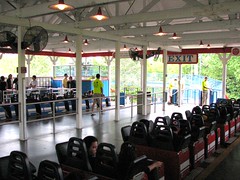
This was not a coaster I liked much before, or ever gave much thought to it. Which genius was it that thought a gigantic helix in the middle of a twin-tracked coaster would be a good element to ensure evenly timed races? The plus-plus-sized heights and speeds only meant that a): the fast parts would be all the more rough and unbearable, and b): they would quickly be braked, turning it into one of those overscaled lame duck monstrosities. Being one of only two coasters in the park without Flash Pass entry is also not a good omen; the station is located behind the railroad tracks leading to an awkward, half-mile queue over and around obstacles that would be nearly impossible to integrate a Flash Pass merge point with, not that it matters since no one bothers to ride it anyway.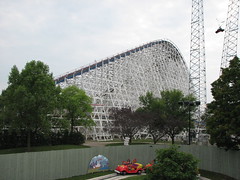
We’re poised on the edge of the first drop (147 ft, second largest drop in the park and still well within the top ten for wooden coasters) and here’s a good sight to behold: no trim brakes anywhere along the first stretch of the ride (evidently I’ve been conditioned by Mean Streak to just assume they will be a prominent feature on any coaster that predates CCI’s first work). The train falls way down, partially into a valley, the return tracks flanking either side of us and creating a cool support bridge overhead as we pull out of the first drop.
The official statistic for speed is 66 mph. Normally I take those values with a grain of salt, 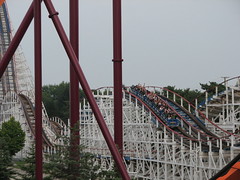 at least for older coasters that probably haven’t run at their listed speed since opening season, but with no trim brakes or anything else holding us back, I must say, it felt fast. Almost dangerously fast. Despite the high speeds it wasn’t rough; those excellent Viper crews obviously have been spending a fair amount of time on the Eagle as well. There was however a strong vibration, unlike anything else I’ve ever experienced: an extremely fine-but-aggressive vibration, like we’re sitting in a vibra-massage chair set on high. It doesn’t jostle us around in our seats in any particular direction, it just rattles our nerves while our center of gravity moves smoothly forward like we’re on Raging Bull. It also rattles my nerves thinking about how ridiculously over-speed we must be going to get this sort of sensation.
at least for older coasters that probably haven’t run at their listed speed since opening season, but with no trim brakes or anything else holding us back, I must say, it felt fast. Almost dangerously fast. Despite the high speeds it wasn’t rough; those excellent Viper crews obviously have been spending a fair amount of time on the Eagle as well. There was however a strong vibration, unlike anything else I’ve ever experienced: an extremely fine-but-aggressive vibration, like we’re sitting in a vibra-massage chair set on high. It doesn’t jostle us around in our seats in any particular direction, it just rattles our nerves while our center of gravity moves smoothly forward like we’re on Raging Bull. It also rattles my nerves thinking about how ridiculously over-speed we must be going to get this sort of sensation.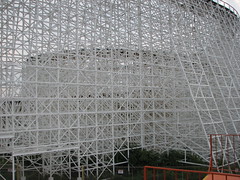
Two very low bunny hops keep this incredible pace up as we get lifted over the crest of each hill for a couple moments of floater air. “Now this is what more roller coasters should be like,” I think as we rush through the final valley before the big pull-up, the terrifying speed melting the immediate surroundings into a blur as we charge along with the utmost control, feeling as though something could go wrong at any moment even though it hasn’t. A brake run is found at the top of this hill, not a big deal because we’re so far up that the train has slowed to 10 mph anyway. While the pacing has slowed to almost nil, the downward helix works very effectively at slowly building tension, as the speed continues to increase as we make our way around it, laterals increasing, rattling getting heavier and heavier until we reach full speed in the last stretch. The slow building tension lets up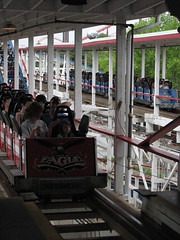 for a fast, straight stretch of track as we cross under the upper layer of the helix, and then it implodes. A dip taking us the rest of the way to ground level comes out of nowhere and hits us hard, especially riding in the back seat. Strong ejector air sustained for several long moments as the speed blasts back into the dangerous levels it was on the first leg of the journey. Some more lean, mean airtime hills follow (it differs slightly depending on which side of the track you’re on, I think the left side may have had one more hill) showing off just how much power this coaster has when it’s running at full speed.
for a fast, straight stretch of track as we cross under the upper layer of the helix, and then it implodes. A dip taking us the rest of the way to ground level comes out of nowhere and hits us hard, especially riding in the back seat. Strong ejector air sustained for several long moments as the speed blasts back into the dangerous levels it was on the first leg of the journey. Some more lean, mean airtime hills follow (it differs slightly depending on which side of the track you’re on, I think the left side may have had one more hill) showing off just how much power this coaster has when it’s running at full speed.
The ride I described above could easily find its way onto my top 15 list of wooden coasters, but unfortunately those high-speed sections last too briefly, and on the return run we are halted after only two or three hills with a brake run that spits us into a pointless helix finale. Very slow by comparison to the rest of the ride, it’s also probably the roughest, and in general breaks flow and feels like it belongs to a different ride. After that distraction we’re greeted with another brake run, this one final.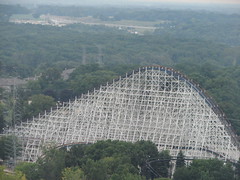
I wish I got more than just three rides on it, since I’m not sure I can count on the American Eagle running this well in the future. Especially with fast wooden coasters like this, the slightest variations such as the day’s temperature or humidity or the weight distribution of the train can start that refined vibration into a shimmy that eats away at the track and before we know it we’re on the one-way pain train to chiropractor junction. Hopefully the maintenance crew knows how to keep it in this condition since it truly was one of the better coasters at Six Flags Great America, and one of the better wooden coasters I’ve been on in general. It’s a beautiful ride as well, and if they could just figure out a better way to connect the station to the rest of the park and get some more crowd flow to that back corner of the park, I think it could be one of Six Flag’s more popular attractions. Even my mom, who generally has a low tolerance for rough or uncomfortable coasters, was first to admit before me that this was her favorite coaster in the park that day.
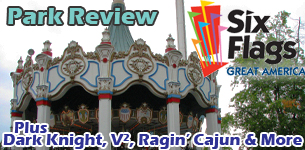
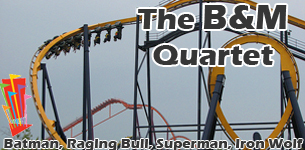
I didn’t even know this thing existed. Worlds of Fun had the Zambezi Zinger, the only coaster of this model I’ve ridden. Sadly, it was dismantled and now resides in Columbia as Broca.
It was a great coaster. Except for the three hills at the beginning, it was buried in the trees with tight turns and a great tunnel.
They only ran three cars per train, unlike this one’s four.